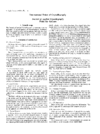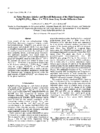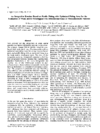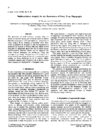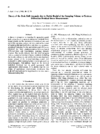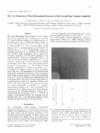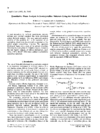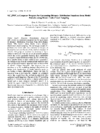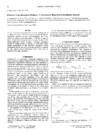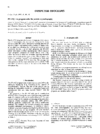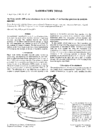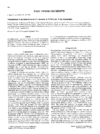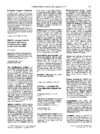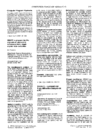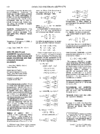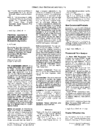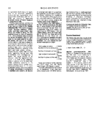issue contents
February 1998 issue

Cover illustration: Powder diffraction pattern of LaB6 obtained using a 200 x 400 mm flat imaging plate mounted at an angle of 45 degrees with the incoming X-ray beam. Experimental conditions: lambda = 0.8884 angstroms, D0 = 104 mm, exposure time 60 s. Courtesy of Poul Norby.
international union of crystallography
Free 

research papers
Small-angle X-ray scattering (SAXS) has been used to study the δ' precipitation in an Al–2.70 mass% Li alloy aged at 463K for 8 and 30h. It is suggested that the dispersive interfacial layer exists between the δ' phase and the matrix.
K2MgWO2(PO4)2 (KMgWP) undergoes at least five reversible solid-state phase transitions/anomalies above room temperature. An ab initio structure determination was performed on the tetragonal high-temperature KMgWP phase at T = 773 K by Rietveld refinement of X-ray powder diffraction data. A brief comparison with KMgWP's triclinic room-temperature modification is given.
Several fits of asymmetric synchrotron, laboratory X-ray and neutron powder profiles are presented. An excellent Rietveld refinement with high-resolution synchrotron data, λ ≃ 0.4Å, illustrates that asymmetry due to axial divergence can be corrected efficiently.
A new program, PROW, is introduced, which allows accurate integration by profile fitting of weak and/or spatially overlapped two-dimensional Laue or monochromatic X-ray diffraction images. The accuracy of the integrated intensities is improved by optimization of the fitting area for each individual spot.
The principles of multiresolution analysis based on wavelet theory are reviewed. This technique is shown to be well adapted to the restoration of noisy X-ray images and is valid for all techniques involving image recording, including electron microscopy.
Analytical Expressions for the Transmission Factor and Peak Shift in Absorbing Cylindrical Specimens
An absorption correction for cylindrical powder or single-crystal specimens, with absorption in the range 0 < μR < is presented.
A neutron optics theory has been developed to describe the scattering physics of the peak shift anomaly due to partial burial of the sampling volume in neutron diffraction residual stress measurements.
The surface acoustic wave effect on X-ray diffraction has been studied experimentally and theoretically for synchrotron applications.
Rotating-crystal monochromatic analysis of CsC24 ex. HOPG (highly oriented pyrolitic graphite) in the range 300–110 K has revealed the structural transitions of Cs atoms submitted to the periodic potential of graphite. The three-dimensional stacking of the graphitic host, and the commensurate and incommensurate modulated structures of Cs, were determined.
The expected positivity of the Patterson map is integrated with the Le Bail method to improve the decomposition of a powder diffraction pattern.
A simple method to perform quantitative analysis on semicrystalline materials using Rietveld refinement is proposed. The method requires knowledge of the chemical composition but it works without any internal standard.
A computer program with an interface to a commercial three-dimensional (3D) modelling package is described. The program generates distance distribution functions from 3D molecular models using Monte Carlo distance distribution chord sampling, which avoids the problem of defining the size of the smallest structure of interest.
short communications
In-plane local arrangements of Ag atoms in the stage-2 intercalation compound Ag0.15TiS2 were visualized by the Monte Carlo simulation technique with the use of two-dimensional short- range order parameters. Microregions of the 31/2 × 31/2 R30° in-plane ordered arrangement become more numerous with decreasing temperature, while the numbers of the other possible ordered arrangements do not depend on temperature.
Experimental evidence for orientational dispersion of an absorption tensor in the X-ray regime has been detected in two amphibole minerals.
computer programs
BLANC is software for protein crystallography that can be used for macromolecular structure solution using various methods (MIR, MIRAS, SIR, MR etc.).
laboratory notes
The design of an X-ray powder diffractometer attachment is described. Some examples of its use with a lithium polymer battery are given.
fast communications
A nondestructive method to visualize inverted foerroelectric domains in periodically poled LiNbO3 by X-ray topography is reported. It is shown that when an electric field is applied to the sample, a strong contrast revealing the inner structure of the domains can be observed, even in white-beam mode.
computer program abstracts
The program gives information about the quality of data collection and provides more realistic standard deviations of structure factors, for high-symmetry systems.
XRDA3.1 provides the necessary tools under the Windows graphical environment to carry out analysis of X-ray diffraction patterns.
Three programs for the transformation of unit-cell data, Miller indices and atomic coordinates are presented
Functions (in Fortran, Pascal and C) to calculate axial- divergence asymmetry are presented.
new commercial products
Free 

books received
Free 



 journal menu
journal menu









